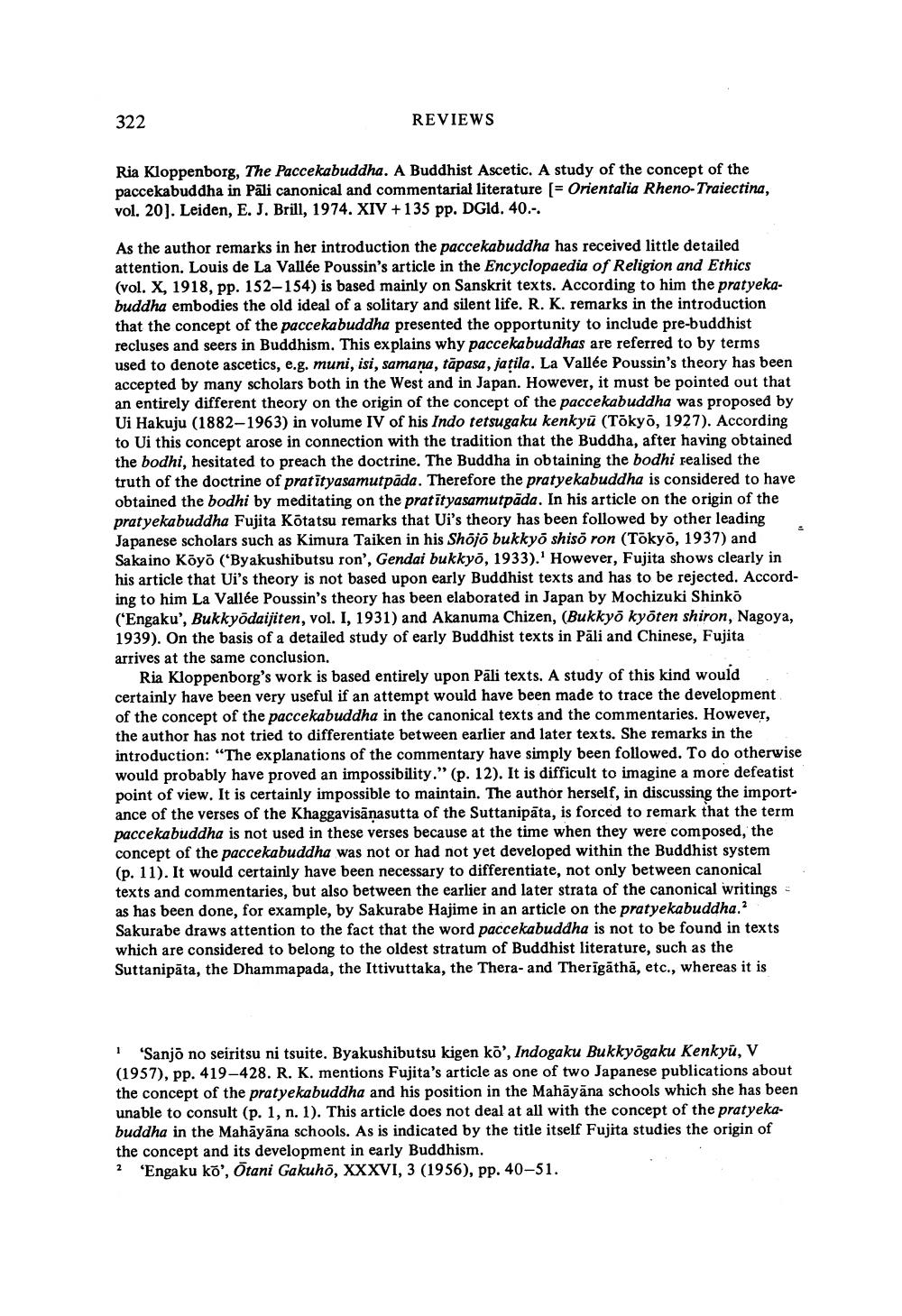________________
322
REVIEWS
Ria Kloppenborg, The Pacce kabuddha. A Buddhist Ascetic. A study of the concept of the paccekabuddha in Pāli canonical and commentarial literature (= Orientalia Rheno-Traiectina, vol. 20). Leiden, E. J. Brill, 1974. XIV +135 pp. DGid. 40...
As the author remarks in her introduction the paccekabuddha has received little detailed attention. Louis de La Vallée Poussin's article in the Encyclopaedia of Religion and Ethics (vol. X, 1918, pp. 152-154) is based mainly on Sanskrit texts. According to him the pratyekabuddha embodies the old ideal of a solitary and silent life. R. K. remarks in the introduction that the concept of the paccekabuddha presented the opportunity to include pre-buddhist recluses and seers in Buddhism. This explains why paccekabuddhas are referred to by terms used to denote ascetics, e.g. muni, isi, samana, tāpasa, jatila. La Vallée Poussin's theory has been accepted by many scholars both in the West and in Japan. However, it must be pointed out that an entirely different theory on the origin of the concept of the paccekabuddha was proposed by Ui Hakuju (1882-1963) in volume IV of his Indo tetsugaku kenkyū (Tokyo, 1927). According to Ui this concept arose in connection with the tradition that the Buddha, after having obtained the bodhi, hesitated to preach the doctrine. The Buddha in obtaining the bodhi realised the truth of the doctrine of pratītyasamutpada. Therefore the pratyekabuddha is considered to have obtained the bodhi by meditating on the pratityasamutpäda. In his article on the origin of the pratyekabuddha Fujita Kötatsu remarks that Ui's theory has been followed by other leading Japanese scholars such as Kimura Taiken in his Shojo bukkyo shiso ron (Tokyo, 1937) and Sakaino Koyo ("Byakushibutsu ron', Gendai bukkyo, 1933).' However, Fujita shows clearly in his article that Ui's theory is not based upon early Buddhist texts and has to be rejected. According to him La Vallée Poussin's theory has been elaborated in Japan by Mochizuki Shinko ("Engaku', Bukkyodaijiten, vol. I, 1931) and Akanuma Chizen, (Bukkyo kyöten shiron, Nagoya, 1939). On the basis of a detailed study of early Buddhist texts in Pāli and Chinese, Fujita arrives at the same conclusion,
Ria Kloppenborg's work is based entirely upon Pāli texts. A study of this kind would certainly have been very useful if an attempt would have been made to trace the development of the concept of the paccekabuddha in the canonical texts and the commentaries. However, the author has not tried to differentiate between earlier and later texts. She remarks in the introduction: "The explanations of the commentary have simply been followed. To do otherwise would probably have proved an impossibility.” (p. 12). It is difficult to imagine a more defeatist point of view. It is certainly impossible to maintain. The author herself, in discussing the importance of the verses of the Khaggavisānasutta of the Suttanipāta, is forced to remark that the term pacce kabuddha is not used in these verses because at the time when they were composed, the concept of the paccekabuddha was not or had not yet developed within the Buddhist system (p. 11). It would certainly have been necessary to differentiate, not only between canonical texts and commentaries, but also between the earlier and later strata of the canonical writings as has been done, for example, by Sakurabe Hajime in an article on the pratyekabuddha.? Sakurabe draws attention to the fact that the word paccekabuddha is not to be found in texts which are considered to belong to the oldest stratum of Buddhist literature, such as the Suttanipāta, the Dhammapada, the Ittivuttaka, the Thera- and Therigāthā, etc., whereas it is
1 'Sanjo no seiritsu ni tsuite. Byakushibutsu kigen ko', Indogaku Bukkyogaku Kenkyu, V (1957), pp. 419-428. R. K. mentions Fujita's article as one of two Japanese publications about the concept of the pratyekabuddha and his position in the Mahāyāna schools which she has been unable to consult (p. 1, n. 1). This article does not deal at all with the concept of the pratyekabuddha in the Mahāyāna schools. As is indicated by the title itself Fujita studies the origin of the concept and its development in early Buddhism. 2 'Engaku ko', tani Gakuho, XXXVI, 3 (1956), pp. 40-51.




